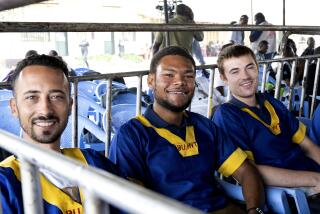U.S. learned late of Colombian bid
- Share via
BOGOTA, COLOMBIA — Although the U.S. government was supposed to have final authority on any plan to rescue three American contractors held by guerrillas, it was kept in the dark by the Colombian military until a week before the July 2 operation to lessen the chances the Bush administration would veto the effort, said a top official close to the operation.
“They wanted to wait long enough to make it difficult to say no,” said the official, who spoke on condition of anonymity because he was forbidden to discuss the topic for attribution.
A Colombian Defense Ministry official, who also requested anonymity, confirmed Sunday that his government had waited until shortly before the operation to inform the United States. However, he said Colombia delayed not because it feared the Americans would oppose the move but “to ensure with certainty that the plan would be executed successfully.”
In early June, intelligence officials in the U.S. Embassy here intercepted communication among rebel leaders at the same time that they noticed the suspicious convergence of groups suspected of guarding the three Americans and other hostages. The officials were part of a 100-person team dedicated to securing the release of the American contractors, Marc Gonsalves, Thomas Howes and Keith Stansell, since they were captured in February 2003 when their plane crash-landed in remote jungle.
Suspecting that a rescue plan was in motion, U.S. officials asked Colombian Defense Minister Juan Manuel Santos, who laid out the daring blueprint on June 25, the first official said.
On June 30, at a meeting of the National Security Council that included Vice President Dick Cheney and Secretary of State Condoleezza Rice, the U.S. gave the green light. American officials here believed chances of success were about 50-50.
Colombian and U.S. officials had long agreed that the latter would have a final say on any effort to rescue the Americans.
On July 2, a 13-member Colombian commando team posing as humanitarian aid workers fooled guerrillas of the Revolutionary Armed Forces of Colombia into loading 15 hostages, including the three Americans and former Colombian presidential candidate Ingrid Betancourt, onto a helicopter that they thought was taking them to meet the rebel group’s new commander. The Colombian commandos instead overcame the two FARC guards and flew the hostages to safety.
The successful operation was far from what the Americans were expecting. The U.S. government had been training and equipping the Colombians to carry out a “humanitarian cordon,” in which about 2,000 Colombian soldiers would be airlifted to surround the location where the hostages were believed to be held. Rescuers would then use loudspeakers and leaflets to negotiate a hostage release.
But that plan carried significant risks because rebels have in the past shot hostages when they suspected a rescue operation was being launched.
In February, one such operation was nearly launched after the three Americans were spotted bathing in the Apaporis River in Guaviare state. The U.S. had moved 900 additional forces to Colombia in anticipation of such a plan. But the mission was scrubbed after Colombian intelligence teams lost track of the hostages.
Although the U.S. anti-drug and anti-terrorism aid package known as Plan Colombia limits to 800 the number of uniformed U.S. forces in Colombia at any time, officials say a separate U.S. law agreed to by Colombia allows for the presence of additional forces to effect the rescue of Americans “held against their will.”
For the July 2 operation, U.S. officials were able to provide minimal help: medical rescue aircraft, backup personnel, tracking devices and technical expertise in hiding two pistols in the helicopter.
Last week, the United States formally requested the extradition of the two rebels who had been guarding the hostages: Gerardo Aguilar Ramirez, alias Cesar, and Alexander Farfan Suarez, alias Enrique Gafas, on kidnapping, terrorism and drug trafficking charges.
In a statement issued Friday on a website, the FARC said the rescue was made possible by the “betrayal” of Cesar and Gafas. The Colombian and U.S. governments have denied that the two rebels facilitated the rescue, as well as reports that as much as $20 million in ransom was paid to FARC members.
--
patrick.mcdonnell@latimes.com
More to Read
Sign up for Essential California
The most important California stories and recommendations in your inbox every morning.
You may occasionally receive promotional content from the Los Angeles Times.










